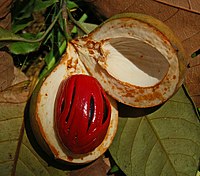
Photo from wikipedia
Golf courses can be characterized as plant communities with a simplified botanical composition. Improving roughs to achieve more naturalized areas can help to enhance the botanical biodiversity on golf courses.… Click to show full abstract
Golf courses can be characterized as plant communities with a simplified botanical composition. Improving roughs to achieve more naturalized areas can help to enhance the botanical biodiversity on golf courses. A 3-yr study was conducted in a Mediterranean climate zone with the objectives of investigating the botanical composition of naturalized roughs by analyzing species richness and effective species number, and assessing the effectiveness of different cultural practices to increase biodiversity. Two sites dominated by either Elytrigia repens (L.) Nevski (Site 1) or by Festuca rubra L. (Site 2) were selected for the study. Three management practices were randomly assigned to plots within each site in May 2013: (i) mowing followed by biomass removal and verticutting, and subsequent supply of hay to provide seeds of local species; (ii) mowing followed by biomass removal and verticutting; and (iii) areas left unmowed (control). Cultural practices had a significant effect on biodiversity in the short-term. The number of plant species at Site 1 was higher in plots receiving Management Practices A and B, and at Site 2 in plots receiving Management Practice A. In contrast, management practice had no effect on the percentages of dominant species. The principal component analysis (PCA) indicated a shift in botanical composition in plots receiving treatments A and B in the second year, while in the last year of the study, the botanical composition of all plots returned to its original state. A single cut in spring was not sufficient to counteract the dominance of highly competitive species.
Journal Title: Agronomy Journal
Year Published: 2018
Link to full text (if available)
Share on Social Media: Sign Up to like & get
recommendations!